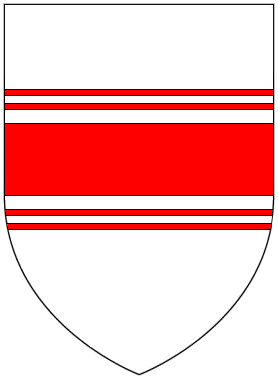
Bartholomew de Badlesmere, 1st Baron Badlesmere was an English soldier, diplomat, member of parliament, landowner and nobleman. He was the son and heir of Sir Gunselm de Badlesmere and Joan FitzBernard. He fought in the English army both in France and Scotland during the later years of the reign of Edward I of England and the earlier part of the reign of Edward II of England. He was executed after participating in an unsuccessful rebellion led by Thomas, 2nd Earl of Lancaster.

John de Warenne, 7th Earl of Surrey, was the last Warenne earl of Surrey.

Nicholas de Crioll, of a family seated in Kent, was Constable of Dover Castle and Keeper of the Coast during the early 1260s. His kinsman Bertram de Criol had distinguished himself in these offices during the preceding 20 years and both were near predecessors of the eminent Warden of the Cinque Ports, Stephen de Pencester.
Theobald le Botiller, also known as Theobald Butler, 2nd Baron Butler was the son of Theobald Walter, 1st Baron Butler and Maud le Vavasour. He had livery of his lands on 18 July 1222.
Ashley is a village and civil parish in the East Cambridgeshire district of Cambridgeshire, England, about 4 miles (6.4 km) east of Newmarket. The modern village consists of the two ancient parishes of Ashley and Silverley. Ashley covers 2,250 acres (910 ha) and in the 2011 census had a population of 749. Ashley is in the electoral area of Cheveley ward.

Giles de Badlesmere, 2nd Baron Badlesmere was an English nobleman.

Eastminster, also known as New Abbey, St Mary Graces, and other variants, was a Cistercian abbey on Tower Hill at East Smithfield in London.
Cheveley Castle was a medieval fortified manor house near Cheveley, Cambridgeshire, England.
Sir Nicholas Haute, of Wadden Hall (Wadenhall) in Petham and Waltham, with manors extending into Lower Hardres, Elmsted and Bishopsbourne, in the county of Kent, was an English knight, landowner and politician.
William Gage was a major landowner and the father of the Tudor courtier Sir John Gage KG.
John Darras (c.1355–1408) was an English soldier, politician and landowner, who fought in the Hundred Years' War and against the Glyndŵr Rising. A client of the FitzAlan Earls of Arundel, he served them in war and peace, helping consolidate their domination of his native county of Shropshire. He represented Shropshire twice in the House of Commons of England. He died by his own hand.
Sir John Gage was a major landowner and grandfather of the Tudor courtier Sir John Gage KG.
Eleanor St Clere was the heiress of a substantial number of manors and grandmother of the Tudor courtier Sir John Gage KG.
Sir Philip St Clere was a son of Sir Philip St Clere of Ightham, Kent and Little Preston, Northamptonshire & his wife Joan de Audley. He served as High Sheriff of Surrey and Sussex and was a major landowner whose estates included land in eight English counties.
Margaret de Vere was an English noblewoman, a daughter of John de Vere, 7th Earl of Oxford and his wife Maud de Badlesmere.
Sir Nicholas de Loveyne was a major English property owner and courtier, who held a number of senior positions in the service of King Edward III.
William Devereux of Frome was a member of a prominent Herefordshire family during the reign of Edward II and Edward III. He was an important retainer of Roger Mortimer, 1st Earl of March and Queen Isabella, and a knight of the Bath.
John Devereux, Lord of Munsley, was an Anglo-Norman nobleman living during the reigns of Edward I and Edward II. The Devereux were a prominent knightly family along the Welsh Marches during the thirteenth century, and played an integral role in attempts to control the Welsh Marches during the thirteenth century.

Sir Thomas de Felton was an English landowner, military knight, envoy and administrator. He fought at the Battle of Crécy in 1346, and the Capture of Calais in 1347. He was also at the Battle of Poitiers in 1356. A recurrent figure in the Chronicles of Jean Froissart, he was a signatory to the Treaty of Brétigny in 1360. In 1362 he was appointed Seneschal of Aquitaine. He accompanied Edward the Black Prince on his Spanish campaign. He was taken prisoner by Henry of Trastámara's forces in 1367. In 1372 he was appointed joint-governor of Aquitaine and seneschal of Bordeaux. He caused Guillaume de Pommiers and his secretary to be beheaded for treason in 1377. He was invested a Knight of the Garter in 1381.
Sir Edward de Warren was an illegitimate son of John de Warenne, 7th Earl of Surrey by his mistress Maud de Nerford of Norfolk. He was lord of the manor of Skeyton and also held other lands in Norfolk. His son Sir John de Warren was the first of this surname to succeed to the manors of Stockport and Poynton in Cheshire, and Woodplumpton in Lancashire.




